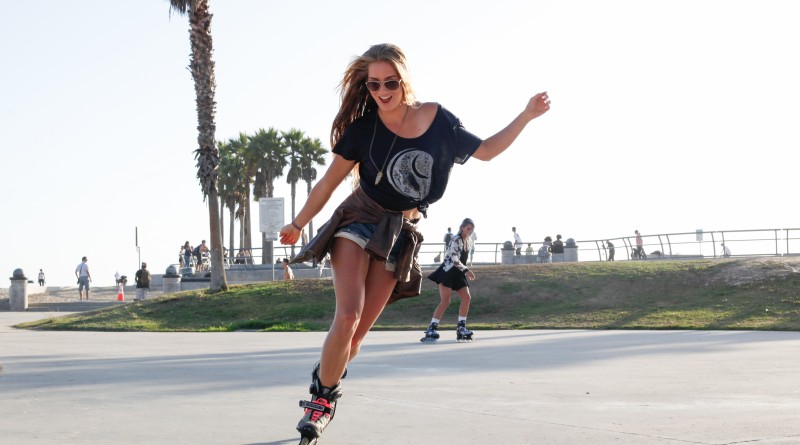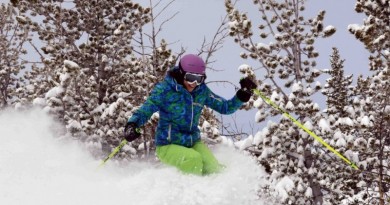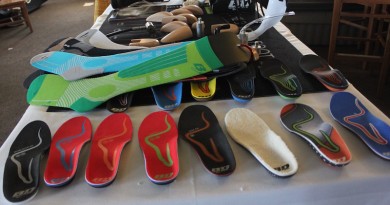How to Build Better Balance
Get ready for winter by training your body for better balance. Here’s advice from a pro. Plus, see all you need for a DIY Home Gym
I’ve been skiing my whole life and teaching skiing ever since my local mountain would let a high school kid put on a ski instructor jacket.
I love the pursuit of skiing well: going fast and carving turns, skiing powder in the glades and catching big air—the sensations are unlike anything else I have found. As a PSIA Examiner, I also help other ski instructors perfect their techniques.
To jumpstart my skiing early season, each fall I hit the gym aggressively to build back my strength, agility and speed. This fall, I am particularly focused on refining my balance.
Balance is a very general skill, but is very important to skiing. “Dynamic” balance is a term often used to describe what we do on skis because we are constantly moving into different points of balance while moving down the hill, never staying in any one spot for more than a split second.
I often think of my dynamic balance training as working the three planes of motion: To keep it simple, I can balance for up-and-down movements, fore-aft movements, or side-to-side movements.
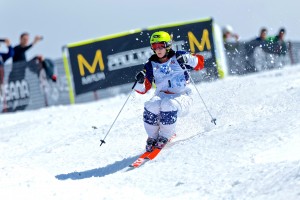
Up and Down
Up-and-down balance involves managing the pressure under your feet. Do I want to extend my legs and add pressure to leave the ground? Or, do I want to soften the pressure and keep contact with a surface under me that may be pushing up against me?
Improving this type of balance is what I call “touch.”
“Touch” is what we see when we watch say, bump skier Hannah Kearney keep her skis in contact with the terrain to stay in control, or when she lets the skis leave the ground when it makes sense. This balance is also important for skiing well in sticky, heavy snow, or in my favorite training condition, breakable crust.
To be ready for skiing with good touch, I’ve added trampolines and slack lines to my fall ski training. The ability to generate or kill bounce on a trampoline is a great way to build this form of balance.
You want to do repetitions of bouncing at the same low level for a few bounces, then add just a touch of height and maintain that level for a while, and then be able to kill it all together by sucking it up and coming to a stop on the trampoline.
Big fancy air beds at gymnastics facilities are the best, but recreational backyard trampolines do the trick too.
It takes time to be comfortable on a surface that isn’t solid, just like the snow we ski on. There’s also the added benefit of big airs and lots of fun grabs, spins and flips.
Slacklines also have this same type of give, which requires touch, but they add the other planes of balance, making them a powerful training tool, which is why ski racers like Lindesy Vonn like to use them.
Learning how to walk a slackline will help create a tall, relaxed stance and shows you how valuable your arms can be in your balancing.
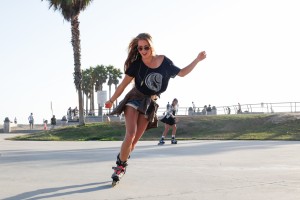
Fore and Aft
While touch can take a lifetime to master, balancing fore and aft may be the most important part of balance for skiing. This is also the part of your balance that can be most strongly affected by equipment. In the fall, it’s great to really find the balance that works for your body and then make sure you can take that onto the hill in your boots and boards when the snow flies.
The ability to use the ankle joint is crucial to good fore-aft balance. Far too many skiers put on a pair of ski boots and lose the ability to use the ankle joint. I love getting on inline skates such as Rollerblades, which have much easier-flexing boots, and doing tons of turns on mellow downhills. Because the wheelbase is much shorter than my skis and the ankle is a little more free, the fore-aft balance training is fantastic. There is no sitting back on inline skates, at least not for long before your butt hits the pavement.
I do ski turns while lifting the inside leg or do little hops while turning (or between turns) to further dial in my fore-aft balance. Inline skates are awesome training tools for a number of reasons (but that’s another article altogether.) If you have never skated before, you owe it to your skiing to try it. Just be careful, because pavement can leave more of a mark than even the Eastern “hardpack” we ski on.
Another quick game I enjoy for working on my fore-aft balance is one I learned from a hockey player. He stands one-footed on a 2×4 that is maybe a foot or two long that’s flat on the floor (toes facing lengthwise) and holds the end of a rope in one hand. On the other end is a training partner with the same set up. The goal is to get the training partner to fall off the 2X4 by pulling and releasing the rope.
This really works your ankle joint for good fore-aft balance. You could also stand on any other balance training device like a Bosu ball, but training with a partner on a 2×4 is a lot more fun.
Side to Side
The third direction of balance is side-to-side or lateral balance. To improve this, this fall I have added a ski simulator to my routine. We are lucky enough to have a great new simulator at Gonzo’s in South Burlington called the SkyTechSport Ski and Snowboard Simulator. The simulator projects a slope on a screen. As a virtual reality reel of a ski slope plays on the screen, you move side to side reacting to the terrain as you tilt your boots in real bindings. The machine actually moves your feet and angles them left and right.
Because you can use your real ski boots, you get valuable boot time before the snow flies. It is also my new favorite way, as a boot fitter, to test a customer’s new boots, or to make boot adjustments. It can highlight lateral alignment problems in a controlled environment and is a great way to make adjustments and immediately see the results.
The machine also allows an expert skier to get a very high edge angle and provides a unique opportunity to train lateral balance for high speed skiing. That’s why the U.S. Ski Team now uses a simulator like this one.
Prior to the simulator, I was addicted to using sport cords for training lateral balance. A sport cord is a strong stretchy cord that can either be attached to your waist with a belt, or has a handle you can hold in front of you. Using a handle can also build great core strength.
With the other end of the cord attached to an anchor of some kind, you can move into a ski turn and use the resistance of the cord to balance against. This is done in your shoes, and you can even lift or tap the inside foot to help focus the balance to the outside foot and leg. I’ve also done this with a partner, which is fun. Instead of having the end of the cord anchored to something stable, it is held or connected to the training partner, who is doing the same move going away from you at the same time. It requires well synchronized moves and really helps train lateral balance.
The other classic way to train lateral balance is by using a balance board, like a Vew-Do board. These boards allow skiers and riders to roll a board on top of a wooden base and are a great way to dial in lateral balance. Doing it with your eyes closed is a good goal for high end skiers and riders.
While training for balance in all three planes is the focus for this discussion, all of these tools will help your skiing in many different ways. Working hard now will help you make this season the best it can be.
A number of years ago I heard a great quote from a five-year-old on a chairlift that I always think about when I’m training. When I asked him how his ski day was going he said “Today’s going great, I’m the best I’ve ever been!”

